Costume designer Ruth E. Carter breaks down the looks in Black Panther: Wakanda Forever
- Oops!Something went wrong.Please try again later.
- Oops!Something went wrong.Please try again later.
- Oops!Something went wrong.Please try again later.
Warning: This article contains spoilers for Black Panther: Wakanda Forever.
Ruth E. Carter made history with Black Panther. The celebrated costume designer helped bring the nation of Wakanda to life in 2018, blending superhero spectacle with real-life African tradition. Her innovative, Afrofuturist vision nabbed her the Oscar for Best Costume Design in 2019, making her the first Black artist ever to win the category.
When it came time to return to Wakanda for the sequel, Carter could've easily relied on the familiar. Instead, the 62-year-old designer expanded the lavish world she created in the first film, crafting a rich visual feast that feels both familiar and fresh. Much of Black Panther: Wakanda Forever centers on the titular African nation, but it also introduces an entirely new culture: the Mesoamerican-inspired underwater kingdom of Talokan. The result is a superhero story that looks — and dresses — unlike anything else on screen.
With Wakanda Forever now in theaters, EW caught up with Carter to break down some of the sequel's most stunning looks. She credits her countless collaborators — including the Marvel visual development team, the historians and oceanographers who offered guidance, and the small army of craftspeople who embroidered, painted, and meticulously assembled every look on screen. "It's a labor of love," Carter tells EW. "Hundreds of artists touch these clothes. Teamwork makes the dream work, and that couldn't have been more true in this case."
The final film boasts more than 2,000 unique costumes, but here, Carter opens up about a handful of highlights — from the new Black Panther suit to that iridescent Midnight Angel armor.
Like brother, like sister
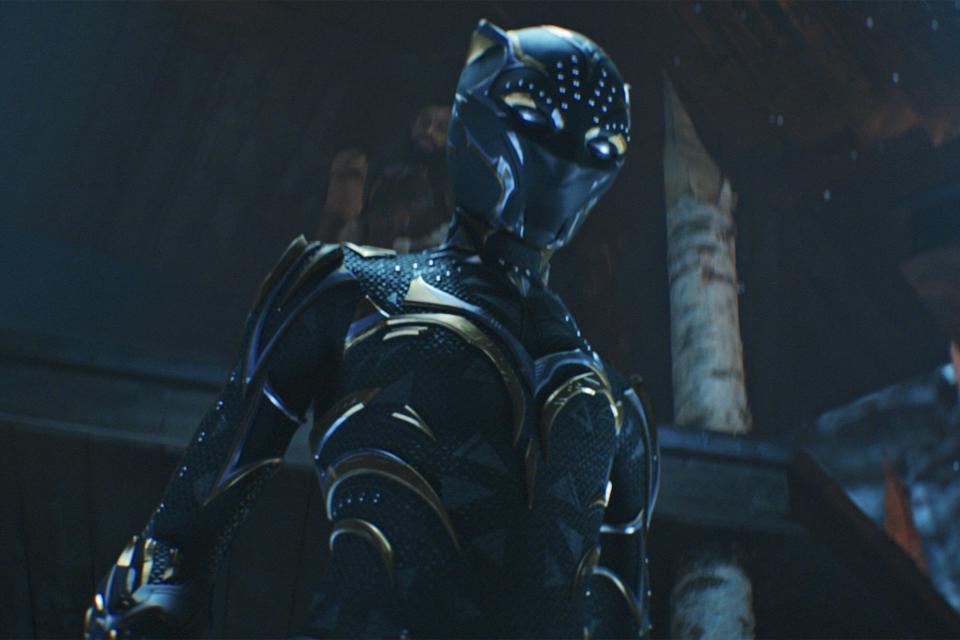
Marvel Studios Shuri's new suit in 'Black Panther: Wakanda Forever'
You can't have a Black Panther movie without a Black Panther suit. The sequel follows the young princess Shuri (Letitia Wright) as she grapples with the death of her older brother T'Challa (the late Chadwick Boseman), eventually vowing to take up his mantle and serve as Wakanda's protector herself. Shuri is a scientist and engineer who constructs her own suit, and Carter wanted her final look to be packed with Shuri-specific details — like the dots on her helmet, which echo the face paint she's previously worn into battle.
"She clearly earns the suit, and it's a big moment in the film," Carter explains. "Therefore, the suit needed to fit not only her physique and her body, but it also needed to have a presence and a brilliance."
Carter worked closely with the Marvel visual development team and art department, sketching out ideas based on Shuri's appearances in Marvel comics. One early sketch hewed closer to Shuri's look on the page, featuring a regal fur collar, but ultimately, that design was scrapped in favor of a sleeker style. Director Ryan Coogler particularly favored a style with elaborate gold and silver vibranium details. "When you think of T'Challa's suit, you see very little silver vibranium," Carter explains. "You see it at the hip line, on the boot line, in the necklace. But Shuri has it all over."
The final Black Panther costume is specially tailored to Wright's physique — the higher neckline, for example, gives it a much leaner, catlike look — but Carter wanted it to still pay tribute to the iconic T'Challa suit. If you look closely at the textured fabric of Shuri's suit, you'll recognize a familiar Okavango triangle pattern, a gorgeous geometric shape Carter first used for T'Challa.
The Midnight Angel takes flight
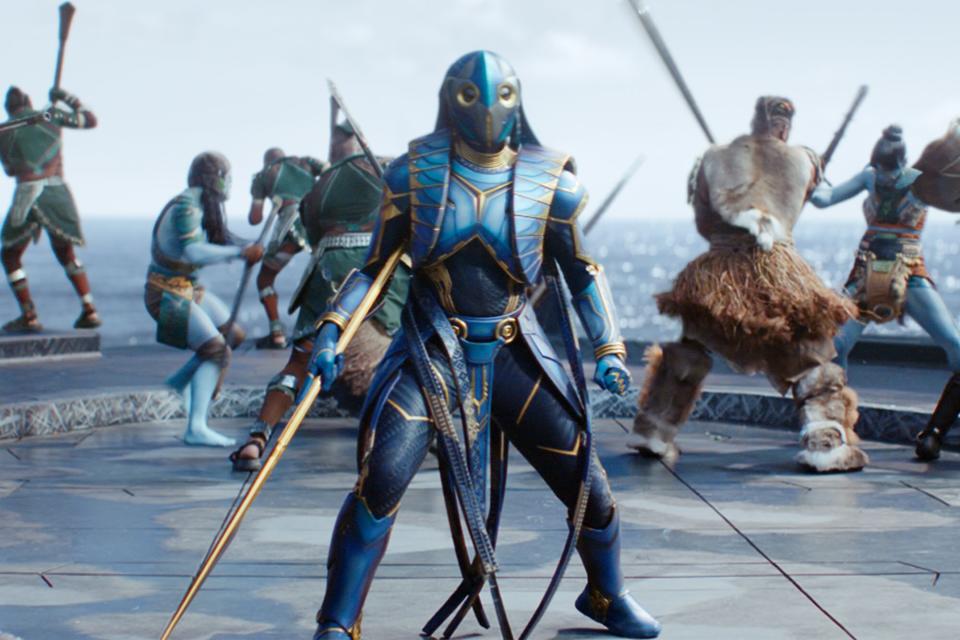
Marvel Studios Okoye (Danai Gurira) in the Midnight Angel armor in 'Black Panther: Wakanda Forever'
Warrior Okoye (Danai Gurira) spends much of the first Black Panther in her red Dora Milaje armor, but she gets an upgrade at the end of Wakanda Forever. Shuri develops a new armor prototype that she dubs the "Midnight Angel," and Okoye wears the final blue suit into battle. (The name is also painted on the armor, using the Wakandan alphabet.)
It's a look that comes straight from the comics — but Carter wanted to tweak it slightly to bring in elements of real African design. The mask was particularly important, and the designer says she experimented with countless versions from different parts of the continent. "We landed on a mask style that's very much like the masks of Benin or South Africa, where you see this slanted eye with a round shape," Carter explains. "There's also this vertical line in the center for the mouth. It felt a bit more like our movie than the comics version."
As for that distinctive blue color? Carter keeps an early gauntlet prototype in her office, and when she spoke to EW via Zoom in early December, she held it up to the camera to show off the iridescent paint. Costume company Film Illusions developed the innovative material, which shifts from greenish teal to blue to purple as the light changes.
Fit for a queen
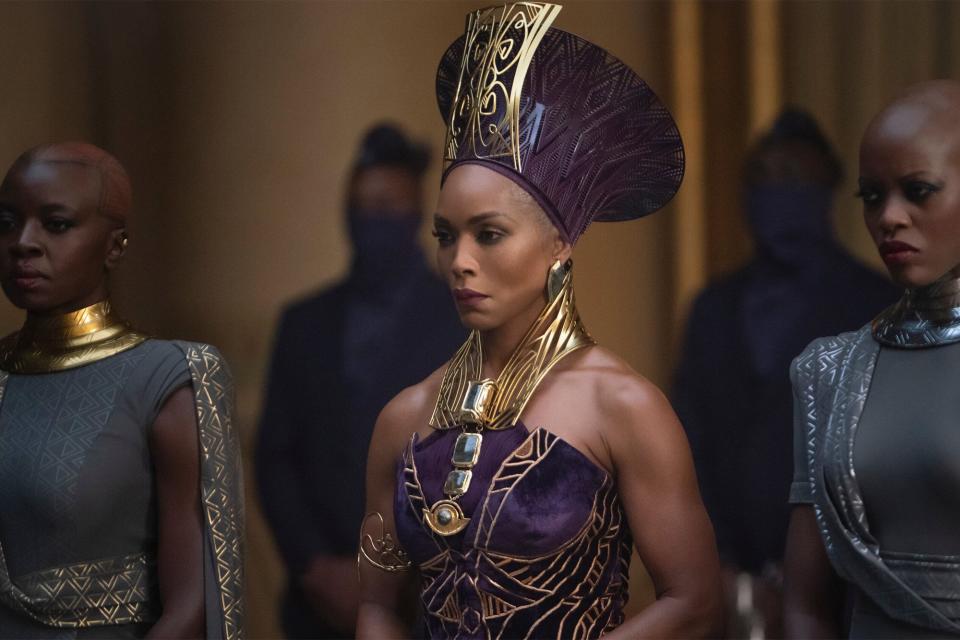
ELI ADÉ/MARVEL STUDIOS Angela Bassett as Queen Ramonda in 'Black Panther: Wakanda Forever'
Carter and Angela Bassett have a long history, having worked together on films like Malcolm X, What's Love Got to Do With It, and How Stella Got Her Groove Back. For Wakanda Forever, Carter designed a whole closet full of royal looks, but her personal favorite might be the regal purple gown that Bassett wears at the beginning of the film. As Queen Ramonda addresses the United Nations, she's decked out in a stunning sleeveless number, complete with gold neckpiece and a 3D-printed isicholo (a traditional Zulu headdress worn by married women in South Africa).
Carter wanted a stark contrast from Ramonda's first appearance in the original Black Panther, where she wears a softer, more maternal look as she welcomes her son home. But her first scene in Wakanda Forever is a powerhouse, and Carter wanted her outfit to be a display of strength, showing how Ramonda has evolved from "queen to ruler." "It was important to set the tone for this film, as we have strong women in charge," she explains. "These exposed arms showed her strength, her beauty, her vulnerability, and her confidence."
"And you know," Carter adds, "Angela Bassett has arms that anybody would envy."
Diving into Talokan
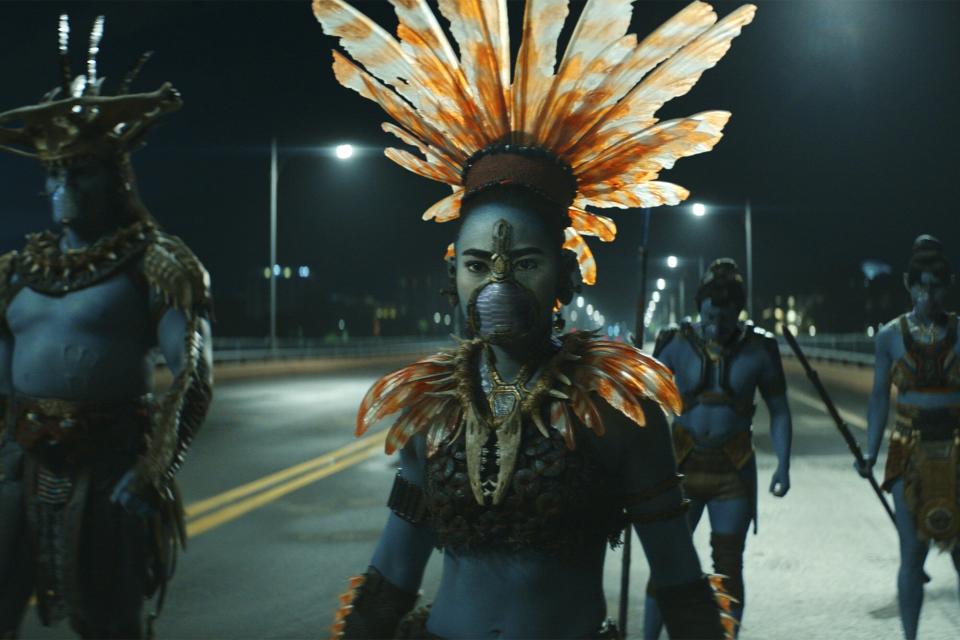
Marvel Studios Mabel Cadena as Namora in 'Black Panther: Wakanda Forever'
Wakanda Forever situates much of its story in the title African nation, but it also introduces the underwater paradise of Talokan, led by the mercurial Namor (Tenoch Huerta). This elaborate civilization has roots in ancient Mayan culture, and Carter met with Mesoamerican historians and experts for insight. The Talokanil people also have a deep connection with the ocean, so Carter brought in oceanographers and biologists for guidance. "They were so excited and so willing to tell us anything that we needed to know," she adds. "It really did give you the confidence that you were doing the right thing."
Talokanil warrior Attuma (played by Alex Livinalli) wears an elaborate helmet inspired by a hammerhead shark, while Namor's cousin Namora (Mabel Cadena) dons a headdress that echoes the fins of a lionfish. "What I love most is when she lands on the bridge, the light comes through it, and it just illuminates it," Carter adds. Still, Carter wanted to make it clear that the Talokanil have a deep relationship with the creatures of the ocean; they're not harvesting bones or fins to use as materials. Not only do the Talokanil have access to vibranium of their own, but they've developed synthetic materials, too. (After all, Carter notes, ancient Mesoamerican people discovered uses for rubber way before Charles Goodyear.)
Of course, one of Carter's biggest difficulties was crafting costumes that not only looked good underwater but functioned properly, too. She and her team designed several stunning looks for the Talokanil, only to discover that dyes would run as soon as they were taken out of the water. (They learned that chlorine or salt could discolor fabric, too.) Certain flowing costumes had to have weights added, so they would move properly on camera.
"Doing costumes for water ballet used to be a bucket list thing for me," Carter says, shaking her head. "But I will check that box off because this was the hardest thing I think I've ever done."
A moving memorial
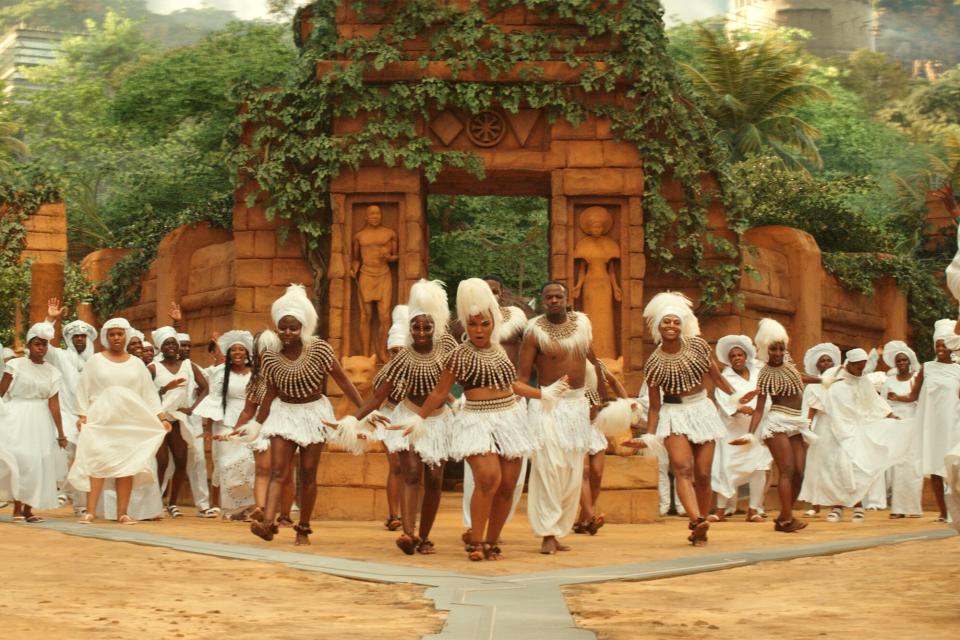
Marvel Studios 'Black Panther: Wakanda Forever'
Despite those underwater complications, one of Carter's trickiest scenes actually takes place on dry land. It comes early in the film, as the entire nation of Wakanda gathers to mourn T'Challa, all of them dressed in brilliant white. The lack of color presented a challenge: Wakanda is comprised of several different tribes, each with their own color palette and history. So, Carter had to figure out new ways to make each tribe feel unique.
"It was pretty intimidating because African fabric is very colorful," she says. "A lot of the identifiers of the region are based on the prints, or the tapestries, or the beadwork. The actual color palettes are different from place to place. So, how do you represent that when everybody has to be in white?"
She and her team experimented with texture and tone, creating patterns by silk screening off-white paint onto pure white fabric. Everything had to be white, from the raffia skirt that M'Baku (Winston Duke) wears to the jewelry and neck rings. "I did a lot of painting," she says with a laugh.
The result is a look that's monochromatic but dramatic — and Carter remembers "screaming with joy" the first time she saw the final result on set.
"Let me tell you, there are a lot of looks at that funeral," she adds. "I hope when [the film] finally starts streaming, people will be able to pause and look and just see all of the detail and hard work that went into it."
Related content:

